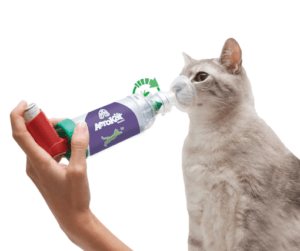Cats can be notorious for hiding illness from their owners, but if your cat is affected with asthma (also known as feline allergic bronchitis), their coughing, wheezing, and difficulty breathing will soon become apparent. This inflammatory disease of the lungs is thought to arise from an increased sensitivity to inhaled allergens such as dust, pollen, or mold spores and may be seasonal or year-round. Left untreated, signs can worsen over time, leading to a cycle of respiratory distress and FAS (fear, anxiety, and stress) that can become life-threatening.
The sheer panic of not being able to breathe is one of the most traumatizing things for pets to experience, so scheduling an appointment when signs are mild and taking a Fear Free approach to the disease will help set your cat up for success.
Signs of Asthma
How do you know if your cat may have asthma? Her coughing is typically dry and looks like an unproductive attempt to bring up a hairball, and you may hear high-pitched respiratory sounds as she wheezes. Increased respiratory rates of more than 35 breaths per minute, increased respiratory effort where the abdomen is heaving in and out with every breath, or vague signs such as lethargy or decreased appetite can be seen. In severe cases, you may also see panting or bluish/purplish color to the tongue and gums, both of which constitute a medical emergency. After a complete physical exam, your veterinarian will want to take some radiographs (x-rays) to evaluate the heart and lungs. Additional testing such as bloodwork or cardiac diagnostics may also be recommended to rule out other causes of coughing.
If the thought of heading to the vet is making your own respiratory rate increase, you’re not alone. I’ve seen numerous cats without asthma arrive at the clinic panting from the high levels of FAS brought on by the carrier and car travel, so when a cat with asthma experiences similar stressors, they can go into a respiratory crisis. It just takes a little bit of planning and good communication with your vet to help avoid a trip to the emergency clinic. Start by following these steps:
- Talk to your vet about PVPs (pre-visit pharmaceuticals), medications that can help reduce the FAS associated with trips to the vet. Cats are not used to leaving their home environment, much less riding in a car, and giving your cat a safe medication such as gabapentin to help relax them two to three hours before their appointment will help with all of the steps needed to transport them to the clinic.
- Get your cat used to her carrier. The last thing you want to be doing when your cat is having a coughing fit is dragging her out from under the bed 5 minutes before her appointment and trying to stuff her into the carrier. Most cats love a cozy hiding spot, so covering the carrier with a towel, putting a cushy bed inside, and keeping it out at all times in a low-traffic area will make it an irresistible piece of cat furniture. Make sure you don’t have a kitten-sized carrier for your adult cat, and try to find a hard plastic carrier with a top entry that can unsnap on the sides so your vet has plenty of low-stress ways to access your cat for the exam.
- Talk to your vet about different medication options for asthma. Steroids are usually required to control lower airway inflammation, and since
 some cats need them long term and even daily, it’s best to avoid forcing your cat to take a pill. The bonds we have with our pets are special, and this also extends to considering the FAS we can cause when giving medications. For oral steroids, a treat-motivated cat may readily take a pill hidden in a piece of cheese, cooked chicken, or commercial pill hider. Non-treat-motivated cats may do better with a compounded flavored liquid. It is not recommended to hide your cat’s medication in her regular food as this may create a food aversion when your cat associates her food with the taste of medication. Inhaled steroids are a preferred alternative to oral steroids because they can cause fewer side effects and are administered through a special adaptor called the Aerokat. With positive reinforcement and training, many cats will accept their inhaler and only need a few puffs a day to control their disease.
some cats need them long term and even daily, it’s best to avoid forcing your cat to take a pill. The bonds we have with our pets are special, and this also extends to considering the FAS we can cause when giving medications. For oral steroids, a treat-motivated cat may readily take a pill hidden in a piece of cheese, cooked chicken, or commercial pill hider. Non-treat-motivated cats may do better with a compounded flavored liquid. It is not recommended to hide your cat’s medication in her regular food as this may create a food aversion when your cat associates her food with the taste of medication. Inhaled steroids are a preferred alternative to oral steroids because they can cause fewer side effects and are administered through a special adaptor called the Aerokat. With positive reinforcement and training, many cats will accept their inhaler and only need a few puffs a day to control their disease.
The good news is that once your cat is diagnosed with asthma and on the appropriate medication, the disease can often be managed successfully long term. If you also plan ahead for vet visits and use a Fear Free way to medicate your cat, you’ll be able to reduce her levels of FAS, help her prognosis, and improve her quality of life.
This article was reviewed/edited by board-certified veterinary behaviorist Dr. Kenneth Martin and/or veterinary technician specialist in behavior Debbie Martin, LVT.








